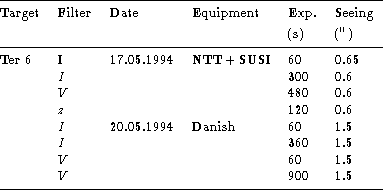The observations were obtained at the European Southern Observatory (ESO), using the 3.55 m New Technology Telescope (NTT) and the Danish 1.54 m telescope.
At the NTT we used
the SUSI camera, which employs a ![]() thinned Tektronix CCD at the
Nasmyth focus B.
The pixel size is
thinned Tektronix CCD at the
Nasmyth focus B.
The pixel size is ![]() m (0.13'' on the sky), and the frame size
is
m (0.13'' on the sky), and the frame size
is ![]() .
The data were collected under excellent seeing conditions (0.6''),
which is fundamental for the photometry of crowded
bulge fields. We provide the log-book of observations in Table 1 (click here).
We show in Fig. 1 (click here)a a NTT z image of Ter 6.
.
The data were collected under excellent seeing conditions (0.6''),
which is fundamental for the photometry of crowded
bulge fields. We provide the log-book of observations in Table 1 (click here).
We show in Fig. 1 (click here)a a NTT z image of Ter 6.

Figure 1: Image of Terzan 6: a) NTT-SUSI Gunn z image;
dimensions are ![]() . b) Danish V
image; dimensions are
. b) Danish V
image; dimensions are ![]()

Figure 2: Cluster V vs. (V-I) diagram for the NTT whole frame

Figure 3: Cluster V vs. (V-I) diagram
for an extraction of radius r < 39''

Figure 4: Cluster I vs. (I-z) diagram:
where the open circles correspond to stars inside a radius
of r < 26'' (cluster) and crosses to stars of
r > 39'' (mostly field)

Figure 5: V vs. (V-I) diagram corresponding to the
Danish telescope whole frame ![]() ,
essentially dominated by the field
stars
,
essentially dominated by the field
stars
At the Danish we used the Tektronix CCD # 28 of ![]() pixels,
with pixel size
pixels,
with pixel size ![]() m, corresponding to 0.37 arcsec/pixel.
The full field is
m, corresponding to 0.37 arcsec/pixel.
The full field is ![]() . In Fig. 1 (click here)b the
Danish V image is shown, where it can be seen that differential
reddening effects are present across this larger field and that the
cluster is located in an obscured area; the cluster nucleus
looks almost stellar-like due to its post core collapse nature.
The Danish observations were taken under
photometric conditions, including Landolt (1983,
1992)
stars, whereas the NTT data were not photometric. For this reason
the zero-point calibrations were obtained based on the Danish
observations, whereas the colour terms were obtained from
NTT data of previous nights.
The reductions were carried out in the standard way, and the calibrations
equations, where Landolt stars were also used, are:
. In Fig. 1 (click here)b the
Danish V image is shown, where it can be seen that differential
reddening effects are present across this larger field and that the
cluster is located in an obscured area; the cluster nucleus
looks almost stellar-like due to its post core collapse nature.
The Danish observations were taken under
photometric conditions, including Landolt (1983,
1992)
stars, whereas the NTT data were not photometric. For this reason
the zero-point calibrations were obtained based on the Danish
observations, whereas the colour terms were obtained from
NTT data of previous nights.
The reductions were carried out in the standard way, and the calibrations
equations, where Landolt stars were also used, are:
![]() and
and
![]() where the numbers are for 30 s exposures and airmass of 1.1.
where the numbers are for 30 s exposures and airmass of 1.1.
We carried out the reductions with the DAOPHOT II package.
The reduction procedure was described in detail
in the Liller 1 and Ton 2 studies (Ortolani et al. 1996a;
Bica et al. 1996),
which were observed in the same run.
The main sources of error in the photometry are the zero
point accuracy (![]() mags) and
the magnitude transfer from the
cluster images to the standard stars due to
the crowded field, which can amount to 0.05 mags. The
photometric errors
are approximately constant to I = 17.5,
amounting to 0.02 mags; at I = 18.5 the error increases to 0.07 mags.
mags) and
the magnitude transfer from the
cluster images to the standard stars due to
the crowded field, which can amount to 0.05 mags. The
photometric errors
are approximately constant to I = 17.5,
amounting to 0.02 mags; at I = 18.5 the error increases to 0.07 mags.

Table 1: Log-book of observations